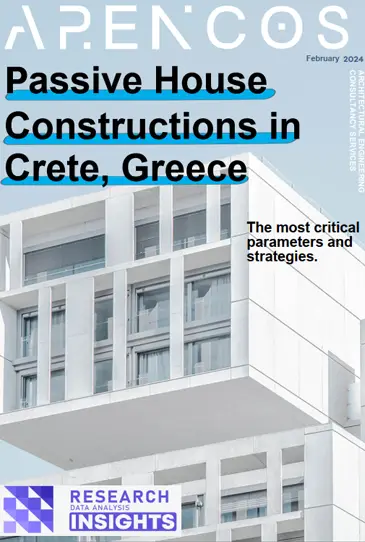The road to affordable energy autonomous housing in Crete.
The SimpleMind Series
Crete's journey to affordable, energy-autonomous housing.
Surging demand for zero-carbon residential properties, materials, and maintanace methods provides construction firms, architects and designers a wide range of opportunities to build exceptional energy autonomous properties.
It provides detailed, best-practice advice to assist with the prevention and reduction of waste as well as the recycling of materials on construction sites.

In Search of Exceptional
Net-zero methods in building and construction: The way forward.
Indeed, greener and more sustainable residential structures in Crete, Greece are magnets for property owners, investors, and buyers. The decisions made by property owners now will determine how their properties are positioned for the transition to the green era over the coming decade.
Those owners that prepare wisely are likely to seek out emerging technologies, eco-friendly and recycled materials, and sustainable ways of living.
To be sure, new materials such as green steel, precast concrete slabs, hempcrete, ferrock, and timber concrete should be among the alternative options to ensure the mitigation of greenhouse gas emissions.
Even if autonomous residential properties meet some principles of green buildings, there is no guarantee that they are really sustainable constructions, since autonomous does not always mean environmentally friendly.
We want to introduce what is likely to be a challenge ten times greater than the delivery of standard residential construction, which is creating a path to sustainable and inclusive growth.
Three critical parameters will drive our goal towards energy autonomy for residential properties in Crete, but we lead with knowledge creation because sustainability and inclusion will not be possible without knowledge.
The aspiration around energy autonomy for residential assets needs to be not only about implementing sustainable technologies, and eco-friendly materials but broader well-being.
That knowledge can spur value creation by integrating sustainable living and broad-based practices, lowering energy consumption, and raising the importance of energy independence.
While knowledge sharing, value creation and stainability are often framed as popular trends, we think about them as a whole. We need all three for this equation to work towards energy autonomy.

By Stavros Thomas
Leads ARENCOS environmental sustainability and net-zero projects to achieve energy autonomy and operational excellence through close collaboration with colleagues, peers, and external partners.Residential Property Energy Consumption
According to our research, about 50% of the energy consumption in residential buildings is directly related to space heating, cooling and ventilation. As such, reducing building energy consumption by designing smart control systems and by integrating renewable energy technologies and energy-efficient construction materials in buildings are critically important.
| Average monthly consumption | 419,8 kWh |
| Average daily consumption | 13,5 kWh |
| Average monthly consumption per person | 201,9 kWh |
| Average daily consumption per person | 6,5 kWh |
| Standard monthly deviation per household | 38,5 kWh |
| Standard daily deviation per household | 3,6 kWh |
The average energy consumption of residential properties in Crete.
Autonomous Energy Housing & Technologies
Some technologies will be key in driving the transition to net-zero. In Crete, for example, our research suggests that just 10 technologies could drive 75 percent of the emissions abatement required to reach net zero in the island.
This means that, in addition to renewable-energy technologies such as onshore wind and solar photovoltaic, new technologies for zero-carbon residential heating (such as heat pumps), green-hydrogen-based fuels, and rainwater harvesting could support autonomous energy housing.
Energy Needs and Conservation
For property owners, residential assets with high CO2 emissions mean not economically viable and technical feasible properties. This is not only because an energy certificate with poor figures reduces the property’s value but also because it drives up the operation and maintenance costs. If a sale is a future option, such properties are less attractive to buyers.
Benefits for Owners
Energy-efficient and especially energy-autonomous properties significantly increase the building’s value and the opportunities for generating profits. Moreover, energy-autonomous properties with the successful integration of smart metering and eco-friendly construction materials can reduce maintenance and operation costs.
An additional advantage is that, by covering their energy needs via photovoltaic systems on the roof or a wind turbine, owners are not reliant on external energy suppliers.
An Autonomous Philosophy
Technical innovation through state-of-the-art methods of construction, such as modular building, can also significantly mitigate energy and costs through standardization and the use of eco-friendly and locally produced materials.
However, it is unlikely to just be regulations or the standards that drive transformation, as the largest players in construction make it a cornerstone of future strategy.
ARENCOS energy-autonomous housing schemes are designed to create properties that are completely independent of the existing grid network for service provision and to make use of alternative energy sources to provide domestic hot water, light EV charging and power.
In this way, our properties would have no carbon dioxide emissions in operation and would make little or no use of finite resources.
Moreover, we strive to reduce or eliminate space heating. Our residential properties provide exceptional levels of insulation such that it is to be heated by the occupants (a family of four), solar gains through the windows and incidental gains.
Planning for Self-sufficiency in Energy
Renewable Energy Technologies
A wide range of technologies is available to harness RE sources and establish energy autonomy for a residential property. These technologies include solar photovoltaic and thermal systems, wind turbines, biomass burners and digesters, and heat pumps. However, many of these systems are unsuitable or not easy to purchase and install in Crete.
Large solar panels or a wind turbine, obviously cannot be employed in an urban area like Chania City. Although wind turbine systems have been developed for rooftop installation in remote locations, wind energy technology is considered unsuitable for the largest cities of Crete.
Biogas digesters are also not considered because of the need for a sufficient supply of feedstock, which is unrealistic for a suburban residence. Solar (electric and thermal) systems, wind turbines and heat pumps using geothermal energy are therefore considered to be the most suitable RE technologies for an energy-autonomous house in Crete.
Space Heating
A ground-source heat pump uses the year-round relatively-constant temperature of the earth at 2-3 m below the surface. In Chania, this is approximately 16°C. A heat pump uses the energy in the ground to heat the property in winter. In summer, the process can be reversed for cooling by transferring the heat from the building to the ground, using it as a heat sink. In the case of a well-designed sustainable house, cooling should not be required.
In addition to space conditioning, ground-source heat pumps can also be used for hot water. Their main disadvantage is the high cost for the necessary installation and excavation works required compared to conventional HVAC technologies.
Net energy is regularly the result of energy performance calculations. Different energy sources have different utilization parameters and a wide range of potential impacts on the environment, and should, therefore, be weighted in an appropriate way. The concept of “primary energy” is that a factor for each energy source is used to weigh each source against its impact on the environment.
The factor is multiplied by the energy demand and may vary depending on the types and source of energy.

A Modern Approach to Construction
In many countries around the world, residential properties are built the same way as they were 100 years ago. But transformation is happening in the shape of modern methods of construction (MMC).
Modern methods of construction – MMC – is a building process that focuses on off-site and on-site construction techniques as alternatives to traditional construction in order to construct and deliver properties more quickly and efficiently.
By integrating computer-controlled off-site manufacturing techniques and software with planning, design, developing technology, and innovative materials we can significantly reduce time, cost, and carbon footprint.
The Case for MMC in Crete
Many factors impact the implementation of MMC in Crete, Greece, but there are three main drivers:
- The cost and availability of labour
- Supply shortages (recent examples of bottleneck phenomena and availability issues experienced in Crete because of the COVID-19 pandemic and the Russo-Ukrainian War)
- Governmental regulatory framework
Unfortunately, in many cases, the cost of adopting MMC is, or at least has been, higher than traditional construction, which dramatically decreases the incentive to change. However, labour shortages are driving up construction costs. Implementation of MMC, which improves operational productivity and reduces onsite works, offers a potential solution.
The most popular MMC for residential projects are:
- 3D volumetric construction
- Flat slabs
- Timber frames
- Precast panels
- Concrete walls and floors
- Precast foundations
- Twin wall technology
- Thin joint masonry
Start With the Site
In getting to energy independence, you don’t start with renewable energy systems or smart metering. That’s the last thing you should do.
First, it is critically important to analyze the local climate, taking into consideration hours of sunlight, wind patterns, rainfall, and temperature ranges, which will inform the design of the building and your overall energy-autonomy strategy.
The orientation of the property is also very important to accomplish your energy-saving goals. You can orient your building to take advantage of the Mediterranean sun when you want it and shade your building when you don’t need it.
This not only enables you to design an energy-efficient and modern building envelope but also sets your renewable systems up for success.

Mitigating Carbon Emissions & Establishing Energy Autonomy
Reaching energy autonomy will require an immense effort to invent, refine, and deploy a wide range of practices and technologies: those expressly intended to accelerate carbon footprint mitigation.
Already, we see ten practices and technologies as critical to meeting the energy autonomy and net-zero challenge, and we expect others to emerge. As demand for them swells, companies will have opportunities to create significant value while helping to curtail emissions.

Building elements affecting residential building energy performance and energy consumption.
| Category | Details | Used in this study | |||
|---|---|---|---|---|---|
| ARENCOS Survey 2021 | ARENCOS Survey 2021 | ARENCOS Research 2022 et al. (2020) | Architectural Design Standards (2021) | ||
| Building elements | – | – | Shape factor | Building shape | × |
| – | – | – | The amount of sunlight | × | |
| – | Building type | Building type | – | ○ | |
| – | Shape of an opening | – | – | × | |
| – | Awning | – | – | × | |
| Floor type | – | – | Floor type | × | |
| Number of floors | – | – | – | ○ | |
| Floor height | – | – | – | ○ | |
| Building elements | Orientation | Orientation, placement (bearing) | – | Orientation (bearing) | ○ |
| Window performance | – | Window glazing type | – | × | |
| Completion year | – | Building norms | – | ○ | |
| Heat perfusion rate | Heat perfusion rate (wall, roof, window, floor) | Existence of thermal insulation in building envelopes | Heat perfusion rate | × | |
| Area for exclusive use | – | Useful floor area | – | ○ | |
| Zoning | – | Zone, space, void | – | – | × |
| Construction machinery equipment | Heating/cooling system, | Heating/cooling system, | Heating/cooling system, heating/cooling energy source | Heating/cooling system, | ○ |
| Air conditioning area | – | – | × | ||
| – | – | Existence of geothermal energy | – | × | |
| Setting temperature of | Conditions for setting temperature | – | Indoor temperature conditions | × | |
| Heating/cooling system, ventilation infiltration | Ventilation infiltration | – | infiltration | × | |
| – | Ventilation system | – | – | × | |
| – | Hot water System | Solar contribution for domestic hot water, Domestic hot water energy source | Hot water system | ○ | |
| Construction electrical installation | Lighting power density | Lighting system | – | Lighting system | × |
| Electric calorific value | – | – | – | × | |
| – | – | Existence of photovoltaic energy | – | × | |
| – | Electronic devices | – | – | × | |
| Region and climate | Location | Regional condition (location) | Climate zone | – | ○ |
| Meteorological data | Climate settings (weather) | Climate zone | – | ○ | |
| Operation and building usage information | Number of occupant | Number of occupant | – | – | ○ |
| Occupant body heat | – | – | – | × | |
| Building operation Schedule | Building operation schedule | – | High efficiency operation of facilities | × | |
| – | Active form | – | – | × | |
Do you need help?
We're committed to creating spaces that matter.
transformation. sustainability. total architecture. technology. earth materials. knowledge sharing. creativity. innovation.

ARENCOS PHILOSOPHY
How we Think
At ARENCOS we view architectural design and construction engineering as a holistic process of exploration and discovery fueled by limitless thinking.
ARENCOS
Values Commitment
While our business continuously evolves, our core values are remaining constant. They define our way of working and are at the heart of everything we do in the field of architectural and engineering immersive experiences.
creativity/ innovation/ transparency
Digital Ecosystem
Our Businesses
We innovate on a continual basis, following trends and customer needs in the sectors in which we operate. We deliver essential innovations across our businesses— Construction & Civil Engineering, Real Estate, and Property Management.



